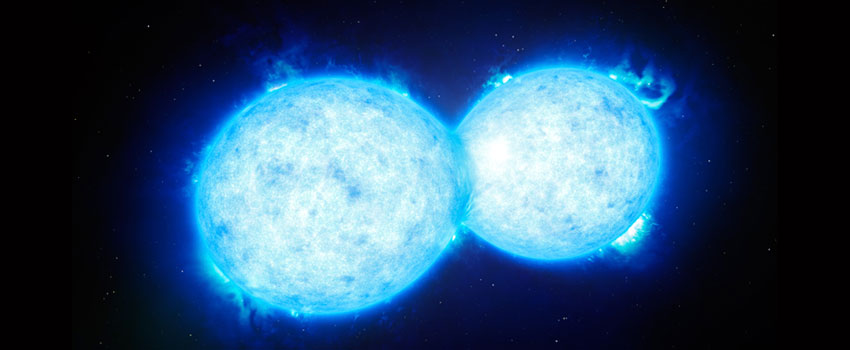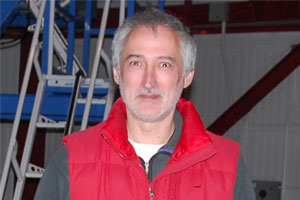- News
ULS researcher participates in the discovery of two giant stars that would have a dramatic “final kiss”

Dr. Rodolfo Barbá, who is part of the team of international astronomers in charge of this important discovery, explains that both stars are orbiting so close that they come into contact and share material. Scientists predict that these could merge and create one or they will end up forming a binary black hole.
The researcher at the University of La Serena, Dr. Rodolfo Barbá, an academic from the Department of Physics and Astronomy of the state university, is part of the group of scientists from various countries who, using the Very Large Telescope of the European Southern Observatory (ESO) ), have discovered the hottest and most massive double star, whose components are so close that they come into contact and also share material. Astronomers predict that both stars that make up the binary star system called VFTS 352, about 160.000 light years away in the Tarantula Nebula (in the Large Magellanic Cloud), could have a dramatic “final kiss,” either with the merger of the two stars and the creation of a single one or the formation of a binary black hole.
Dr. Barbá explains that this binary star has certain peculiarities, “first, it was discovered in a galaxy neighboring ours. This system lives in the star-forming region of the Tarantula Nebula, the most important in the Local Group of galaxies, where it is very likely to find stars of great mass, tens and even hundreds of times the mass of the sun," and he detailed that in the survey where these stars were found, helped with data from other light surveys, it was observed that VFTS 352 suffers periodic eclipses.
 “As they are binary stars, they have a characteristic that makes them very peculiar, which is the fact that they are orbiting very closely around each other, so close that they come into contact. This contact is so deep that then each star, in a certain way, is fused with its companion and gas is exchanged from one to the other and vice versa, that is, a mixture of the plasma of both is produced. The stars are sharing more or less thirty percent of each other's gas," says the ULS researcher and adds that these binary systems "spin very quickly because they are very massive and the orbital movement causes them to move hundreds of kilometers away." per second. That, plus the situation that the gas is shared, makes the classical models of star evolution no longer adequate.”
“As they are binary stars, they have a characteristic that makes them very peculiar, which is the fact that they are orbiting very closely around each other, so close that they come into contact. This contact is so deep that then each star, in a certain way, is fused with its companion and gas is exchanged from one to the other and vice versa, that is, a mixture of the plasma of both is produced. The stars are sharing more or less thirty percent of each other's gas," says the ULS researcher and adds that these binary systems "spin very quickly because they are very massive and the orbital movement causes them to move hundreds of kilometers away." per second. That, plus the situation that the gas is shared, makes the classical models of star evolution no longer adequate.”
The two stars - very hot, bright, massive and almost identical in size - orbit each other in just over a day, and together they have about 57 times the mass of the Sun. They also have components with surface temperatures that exceed 40 thousand degrees. Celsius. As astronomers indicate on the ESO site, “extreme stars like these that make up VFTS 352 play a key role in the evolution of galaxies and are believed to be the main producers of elements such as oxygen” and they clarify that due to Because the stars are so close, “strong tidal forces increase the mixing of materials in the stellar interiors.”
Astronomers predict that this particular system will face a catastrophic fate with two possible endings: One is that the stars merge and become one. The remaining star will rotate at very high speed, which in its final destiny as a supernova could generate a long-lasting gamma ray burst. The other scenario, commented Dr. Barbá, is that the stars do not merge, explode as supernovas and form two black holes orbiting one another. This is because the time it would take to achieve fusion would not be possible within the thermonuclear life of stars. “A star of this style probably has an evolution that at the moment is uncertain,” said the researcher, who added that the so-called “final kiss” of these stars can occur between 2 to 4 million years more.
The academic from the state campus of the Coquimbo Region highlights the magnitude of this discovery and the valuable information it provides about the evolutionary processes of this type of stars. In this sense, he highlights that at the University of La Serena work is being carried out that is complementary to this research, but within the galaxy, mapping and searching for these eclipsing binaries, studies that are funded by FONDECYT projects. As part of this latest investigation, he announced, an even larger binary star was found at VFTS 352.
The work of this group of international researchers has been published this month in the prestigious magazine “Astrophysical Journal”.
